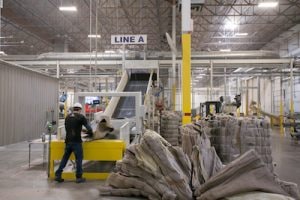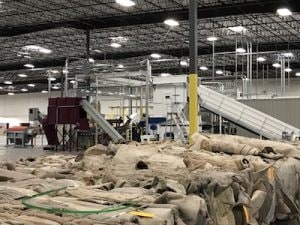Growing switch to polyester carpets puts recycling at risk.
Irwin Rapoport
Aquafil USA, part of Italian-based Aquafil S.p.A. (Trento, Italy) will open production of second carpet recycling plant in the U.S—in Woodland, CA soon to harvest Nylon 6 from nylon-based carpets to regenerate the nylon fraction into new ECONYL® yarns for new carpets.
The $12 million, 120,000-square-foot plant, when production reaches full peak, will add 50 new jobs and bolster the recycling infrastructure needed to help recycle the millions of tons of carpet that are discarded by Americans annually (https://wasteadvantagemag.com/carpet-recycling-op-ed-and-analysis/?fbclid=IwAR104LcfTEmVb0GRMdnYaEJOgu7jvBzda6OYqo0pxpvEeWgr8jv_997l0J8) that either end up in landfills or are used as a fuel source for industry, which generate green house gases.
Removing the Carpet Components
Based in Cartersville, GA, Aquafil USA was started 20 years ago by Franco Rossi and now has two productions factories in Cartersville and two carpet recycling plants in Arizona and California. The area around Carterville is considered to be the carpet manufacturing capital of the world. In fact, more than 100 carpet manufacturers in Georgia purchase Aquafil’s recycled Nylon 6.
“We employ approximately 370 people,” Rossi said. “We developed the technology to regenerate nylon waste to make new nylon and this is why we opened carpet recycling plants in Phoenix, AZ and Woodland to procure waste for the regeneration plant. Their purpose is to deconstruct used carpets and extract the different materials from them. We use carpets from firms that collect them and then separate them.”
The most valuable component of used carpet is Nylon 6, a high-value yarn. The recovered nylon is sent to Aquafil’s ECONYL® regeneration plant in Slovenia to become new Nylon 6, called ECONYL®, which is 100 percent regenerated and infinitely regenerable and used for both carpet flooring and garments.
In addition to Nylon 6, secondary materials can also be recovered.“They contain other materials like polypropylene and calcium carbonate, a mineral and essentially dirt, used for stability,” said Rossi. “The polypropylene is used by manufacturers to create other objects through injection molding, and the calcium carbonate is used to create building materials such as concrete and cinder blocks.”
“With Nylon 6 it is a closed-loop system,” he added. “It can be recycled an infinite number of times without any loss of quality. Unfortunately, for the other materials, it is not and they have to be repurposed. But at least it’s a way to prolong their useful life instead of going straight into landfills as an extremely large majority of carpet in North America does today.”
When the Woodland plant reaches full capacity—36 million pounds of carpet annually, it will be able to disassemble and separate a nylon-based carpet to its components within 30 minutes. The Phoenix plant opened last April and production at that location is increasing.
The Need for Infrastructure
Aquafil’s parent company has 16 plants in eight countries, including Italy, Slovenia, Germany, UK, Croatia, China and Thailand. The California plant, which employs wet and dry measures to deconstruct carpets, is also environmentally-friendly. The water can be re-used, and renewable energies are maximized.
In Arizona, carpet recycling does not receive any subsidies, but in California, carpet retailers have been charging 35 cents per-square yard of new carpets that they sell. The assessment started in 2011 at 5 cents per square yard after passage of AB 2398, with subsequent increases to reach the current 35 cents as of January 1, 2019 (https://carpetrecovery.org/california/).
Rossi is keen for Aquafil to open more recycling plants across America.“Our appetite is large, and we can definitely absorb carpets from many states,” he said. “But the entire system works in a subsidized environment like the one in California where the consumer pays a recycling fee at the point of purchase and the funds are distributed to carpet collection firms and recyclers to help with their costs of operations.”
“Due to the way carpet is made today,” he added, “it’s not going to be economically feasible to operate these facilities like the one we have in Woodland without legislation. If there are other states that would pass legislation to favor carpet recycling, we are ready to start up facilities.”
Disposal Concerns
Having states bring in EPR legislation is just one aspect of the many conditions required to recycle carpets in America, and many recycling groups and associations are working hard to have as many states as possible enact them.
“About 85 percent of carpet nationally is put into landfills,” said Heidi Sanborn, executive director of the Sacramento, CA-based National Stewardship Action Council (NSAC. “It’s a huge problem when most carpet is plastic, made from fossil fuels, and we have the industry as a whole not doing anything to make a real difference in closing the loop when the best they have done is increase recycling less than one percent a year in California. We don’t think the public could understand the situation because they are being told to buy ‘earth-friendly’ carpet made from recycled water bottles that is not recyclable, so the public is confused on how to buy greener carpet. We need to send the right cost signals to the public, be it through visual or internalized increased costs for the harder to recycle carpet so the public can determine through the product price, which carpets are designed for recycling.”
Rossi is very concerned about another situation that is literally throwing a spanner into the works and could seriously derail overall efforts to recycle carpets in the U.S.—the move from nylon to polyester-based carpets over the past seven years.
“Polyester is a cheaper material,” he said, “it cannot really be recycled into anything and it has a very low value once it has been discarded. We could potentially recycle all the carpet in the world if it was made from Nylon 6, but the industry has decided to move into polyester and our mission is made harder because 70 percent of carpet that is collected today for recycling is polyester and only 30 percent is Nylon 6.”
This is already having an impact on firms collecting the carpet because their work is made more difficult via the separation process and they have fewer viable products to sell to Aquafil and other companies.
Then there is the question of what to do with polyester carpets.“There’s not really an economical or good use for them,” said Rossi, “and the manufacturers are pushing towards polyester which costs less to produce. The problem downstream is that nobody wants it. Subsidies are needed to find a home or a place for this material.”
The Concern about Growing Polyester Carpet
A key question that all should ask, particularly when there is a growing environmental awareness and recycling ethos, is why governments are permitting a product to be manufactured that cannot be recycled? It is not as if a large percentage of people and governments are unaware of the problem that polyester carpets pose now and in the future.
“I understand what you’re saying,” said Rossi, “but that is what the manufacturing industry is thinking—the use of polyester is driven by its short-term goals. They need to produce as much as possible with the least expensive raw materials, even if that material is hard and expensive to recycle. Without additional legislation, the carpet industry is not going to change its tune. They’ll do what they think is best for their business and let somebody take care of it eventually.”
What can be done in terms of recycling polyester? So far Rossi stressed that the situation looks bleak.“The only solution at the moment is to use the fiber as such in what are called agnostic applications, where the ingredients used doesn’t matter because it’s only used as insulation, pads, inexpensive fabrics, and some decking material,” he said. “These products need a material that melts easily or is fluffy. But once the material is used for this application, there is no way to recover it again and so it’s not the ideal in the future circular economy scheme.
“If they are not sold at a low price,” he added, “there are alternatives that can be used instead. That is why we need legislation to be able to properly recycle polyester carpets. It needs to be subsidized and applications need to be found for the use of the recovered material so that we have an economic justification.”
The NSAC, like other groups, is concerned by the explosive growth in polyester carpet use and is working towards effective solutions, stressing that governments are not recognizing the problem.“Many states, and even the EU, were not paying attention to this plastic fiber,” she said, “but with almost four percent of our total waste disposed and the product is derived from fossil fuels, why do we continue to overlook it? This is a clear example of why a society-wide understanding is needed to produce products that can easily be disassembled and recycled, which means we need to require standardized labeling so the public can trust what they are being told is the truth about the recycled content and recyclability of the carpet.”
“The long-term problem is our population is still growing,” she added, “and we are running out of resources. No one wants to live near a landfill or combustion plant, and we have climate change. We need to move quickly to a circular economy for all flooring, carpet and engineered floors. We are grateful to leaders like Interface Carpet and recyclers like Aquafil. Recycling carpet will create many more jobs than disposal in the U.S., so the states should be incentivized to pass carpet EPR legislation and we are eager to help them!”
Moving Forward
Added Rossi: “The problem needs to be solved as soon as possible because now we are recycling carpets that have 5/10 years or more and it’s a complicated system. But in the future, the idea is to make carpets and any other objects as easy to disassemble as possible, so that they can be recycled into the main components and the materials can go back and be used again and again.”
Praising the efforts of Rossi and Aquafil USA is a given as the company is demonstrating that one can move forward with profit-based actions to help protect the environment. This company and a host of others and potential entrepreneurs are keen to create the infrastructure needed to recycle consumer and commercial products and the markets for the recovered materials.
Hopefully, other states will recognize some of the root issues with regards to carpets and recycling and pass carpet EPR legislation to build on what California has done to increase the number of green jobs in their state and regionally.
Irwin Rapoport is a freelance writer with extensive knowledge of the waste and recycling sectors. He can be reached at [email protected].



